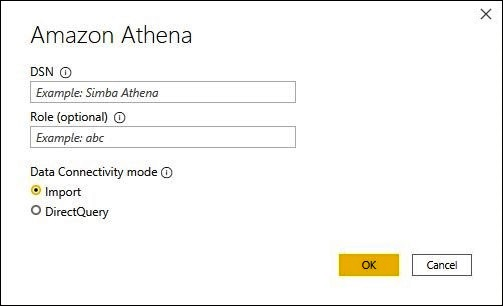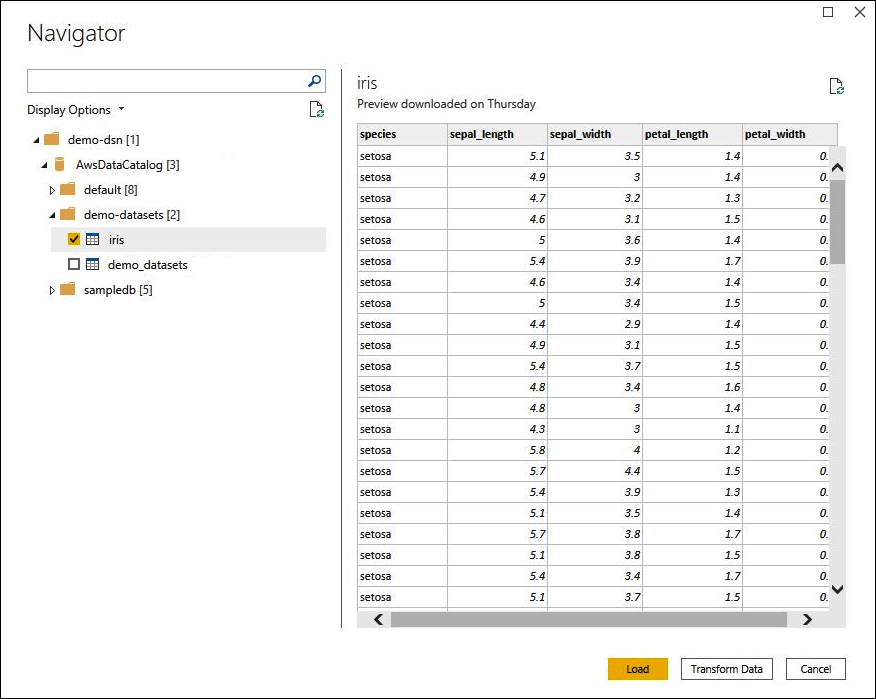Use the Amazon Athena Power BI connector
On Windows operating systems, you can use the Microsoft Power BI connector for Amazon Athena
to analyze data from Amazon Athena in Microsoft Power BI Desktop. For information about Power
BI, see Microsoft power BI
Prerequisites
Before you begin, make sure that your environment meets the following requirements. The Amazon Athena ODBC driver is required.
Capabilities supported
-
Import – Selected tables and columns are imported into Power BI Desktop for querying.
-
DirectQuery – No data is imported or copied into Power BI Desktop. Power BI Desktop queries the underlying data source directly.
-
Power BI gateway – An on-premises data gateway in your AWS account that works like a bridge between the Microsoft Power BI Service and Athena. The gateway is required to see your data on the Microsoft Power BI Service.
Connect to Amazon Athena
To connect Power BI desktop to your Amazon Athena data, perform the following steps.
To connect to Athena data from power BI desktop
-
Launch Power BI Desktop.
-
Do one of the following:
-
Choose File, Get Data
-
From the Home ribbon, choose Get Data.
-
-
In the search box, enter Athena.
-
Select Amazon Athena, and then choose Connect.

-
On the Amazon Athena connection page, enter the following information.
-
For DSN, enter the name of the ODBC DSN that you want to use. For instructions on configuring your DSN, see the ODBC driver documentation.
-
For Data Connectivity mode, choose a mode that is appropriate for your use case, following these general guidelines:
-
For smaller datasets, choose Import. When using Import mode, Power BI works with Athena to import the contents of the entire dataset for use in your visualizations.
-
For larger datasets, choose DirectQuery. In DirectQuery mode, no data is downloaded to your workstation. While you create or interact with a visualization, Microsoft Power BI works with Athena to dynamically query the underlying data source so that you're always viewing current data. For more information about DirectQuery, see Use DirectQuery in power BI desktop
in the Microsoft documentation.
-

-
-
Choose OK.
-
At the prompt to configure data source authentication, choose either Use Data Source Configuration or AAD Authentication, and then choose Connect.

Your data catalog, databases, and tables appear in the Navigator dialog box.

-
In the Display Options pane, select the check box for the dataset that you want to use.
-
If you want to transform the dataset before you import it, go to the bottom of the dialog box and choose Transform Data. This opens the Power Query Editor so that you can filter and refine the set of data you want to use.
-
Choose Load. After the load is complete, you can create visualizations like the one in the following image. If you selected DirectQuery as the import mode, Power BI issues a query to Athena for the visualization that you requested.

Setting up an on-premises gateway
You can publish dashboards and datasets to the Power BI service so that other users can interact with them through web, mobile, and embedded apps. To see your data in the Microsoft Power BI Service, you install the Microsoft Power BI on-premises data gateway in your AWS account. The gateway works like a bridge between the Microsoft Power BI Service and Athena.
To download, install, and test an on-premises data gateway
-
Visit the Microsoft power BI gateway download
page and choose either personal mode or standard mode. Personal mode is useful for testing the Athena connector locally. Standard mode is appropriate in a multiuser production setting. -
To install an on-premises gateway (either personal or standard mode), see Install an on-premises data gateway
in the Microsoft documentation. -
To test the gateway, follow the steps in Use custom data connectors with the on-premises data gateway
in the Microsoft documentation.
For more information about on-premises data gateways, see the following Microsoft resources.
For an example of configuring Power BI Gateway for use with Athena, see the AWS Big
Data Blog article Creating dashboards quickly on Microsoft power BI using amazon
Athena